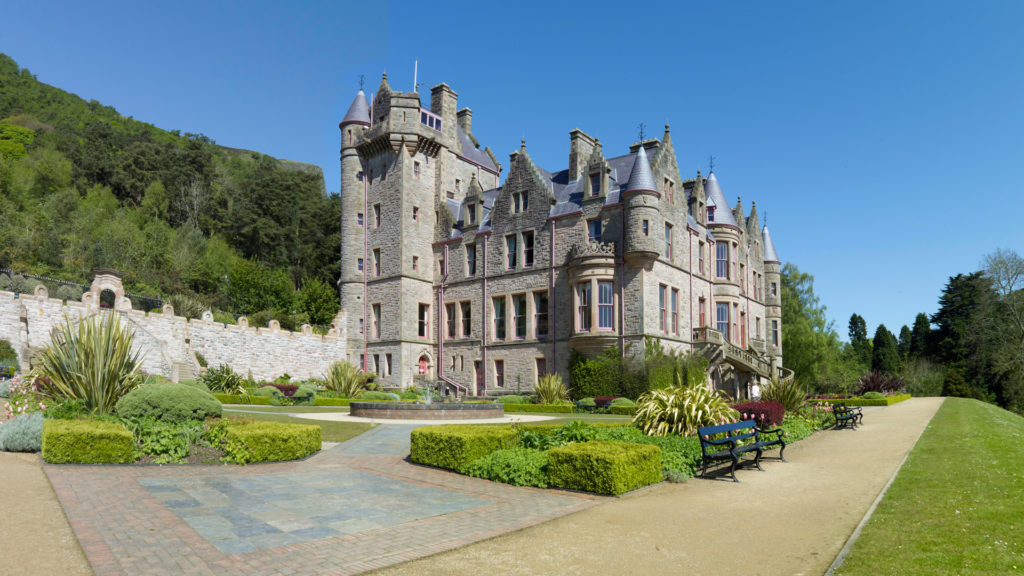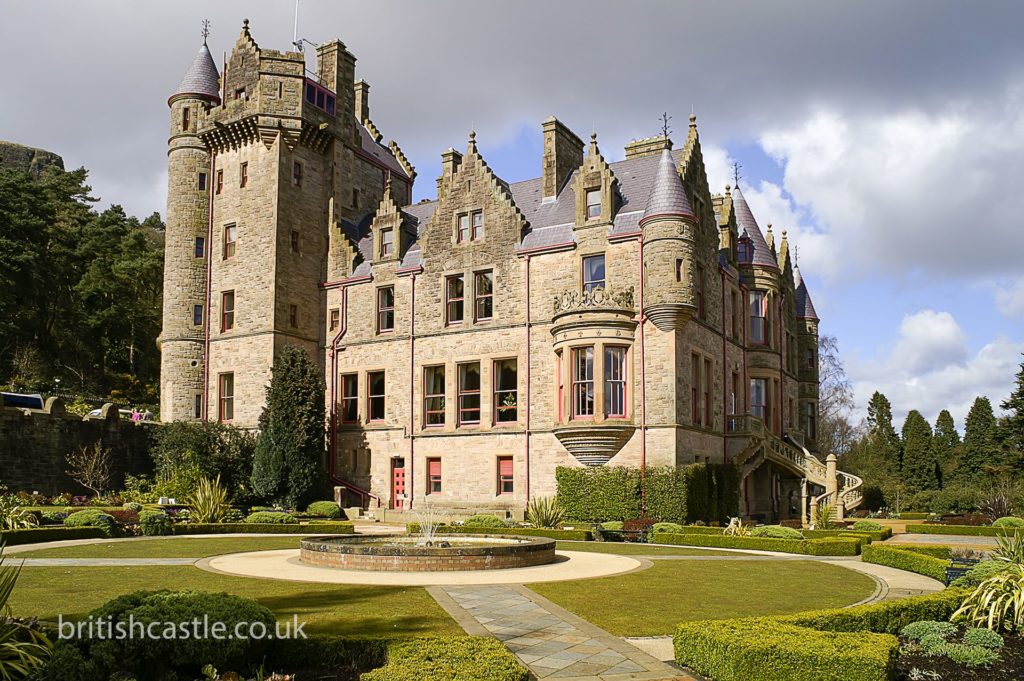Like much of Great Britain, Northern Ireland is teeming with history––and much of that history is represented by medieval manor houses and fortresses, many of which still stand to this day. One castle, in particular, the origins of which date back nearly a century, has borne witness to some of the country’s most significant periods of change and rebirth.
Early Belfast Castle: Cave Hill Country Park, Northern Ireland
The original Belfast Castle no longer exists. Built by the Normans, possibly a John De Courcy, in the latter part of the 12th century, the original castle was located in what is now Belfast City Centre.
Despite its current position, Belfast Castle has existed throughout centuries in many different forms and iterations––the earliest of which was erected around the 1220s, on what would later become the County Antrim side of the River Lagan. The medieval structure was likely built (and rebuilt many times) by the Normans, in what is currently Belfast City Centre, abutting Donegall Place and Castle Lane.
Between the 13th and 16th centuries, this original castle would be seized again and again by opposing forces––most notably, the early O’Neill dynasty, who are some of the earliest claimants to the property. Belfast Castle would be wrenched from the hands of the O’Neill clan throughout the 1400 and 1500s, once by Ulsterian Gaelic rulers, and then by English armies.
A new castle was built upon the same site in 1611 by Sir Arthur Chichester, gifted the Castle of Belfast and surrounding lands a few years earlier by James the First. In 1708 this castle was destroyed by fire and never rebuilt.
Belfast Castle throughout the years
Like many fortresses around the time, Belfast Castle experienced years of infighting and witnessed continued battling between neighbouring factions––in most cases Irish independents and the ever-ruling English. One of the most notable rebellions to occur during Castle Belfast’s life was Tyrone’s Rebellion, or the Nine Years’ War, in 1603. The castle, however, by now in a severe state of disrepair, was still considered a valuable defensive post during wartime.
The Chichester Era
Sir Arthur Chichester, 1st Baron Chichester (and who would go on to become Lord Deputy of Ireland in 1605), offered to rebuild Belfast Castle from its decrepit state provided the English Crown would officially “grant” him the property and the area’s surrounding land––including estates in Country Donegal and Ulster. Chichester, one of the primary architects during the Plantation of Ulster (a mass colonisation project that first took place throughout Great Britain around 1609), set about re-purposing the Belfast Castle’s outer structure in stone, timber, and non-traditional brick. Historians generally refer to this period of Belfast Castle as the “Plantation era”. But it would not be for long.
In 1708, a fire would break out at Belfast Castle, killing four residents, including three of Sir Arthur’s sisters. The fortress was destroyed and the Chichester family, united in grief, would leave the area. However, it would remain in somewhat close ties to the family well into the late 1800s.

The most recent Belfast Castle is now situated in the north of the city on Cave Hill affording great panoramic views of the city and Belfast Lough.
Completed in 1870 the new castle, said also to be a fine and stately mansion, was built by the third Marquee of Donegall, a descendant of Sir Arthur Chichester.
The Donegall Era
The 2nd Marquess of Donegall decided to settle in Belfast around 1802––and he and his family would need a place to live. They settled in what would become Donegall House which, at the time, was only a few hundred yards from the original medieval Belfast Castle site. The Marquess also owned Ormeau Cottage (current Ormeau Park––the oldest municipal park in Belfast) located in South Belfast, which he would eventually expand into Ormeau House and retain as his primary residence, selling off Donegall House in the 1820s.
Following the Marquess’s death in 1844, his son, the 3rd Marquess of Donegall, who had led a storied military career that took him away from Belfast for most of his adult life, returned home to sell off the family’s estates––including Ormeau House. However, he would eventually decide to stay in the area and build himself a spectacular stead on the grounds of what was left of his family’s domain. This new build, situated in north Belfast, on the slopes of Cave Hill, would be called Belfast Castle.
This castle, erected anew in 1867, was constructed using local pink sandstone and sat atop an inclined tract of land which offered unparalleled views of the town. By the time of its completion in 1870, now Lord Donegall had amassed whopping costs and thus sought assistance from his son-in-law, Baron Ashley (who would become 8th Earl of Shaftesbury) who was married to Donegall’s sole surviving daughter, Lady Harriet Chichester.

The Shaftesbury Era
In possession of Belfast Castle for only a few years upon the death of the 3rd Marquess in 1883, the 8th Earl of Shaftesbury himself would die in 1886, leaving the site to his then-teenaged son, Anthony-Ashley Cooper, the 9th Earl of Shaftesbury. Ashley-Cooper, as a result of his age, would remain in possession of Belfast Castle––as well as the family’s other estate holdings––longer than any other private owner. A dutiful and proud resident of the area, the young Earl would serve as Lord Mayor of Belfast in 1907, eventually becoming simply Lord Shaftesbury.
A philanthropic at heart, Lord Shaftesbury would go on to sell the various estates of the Donegall family, while residing in Belfast Castle. Following the terms of the British Land Acts, and due to the overwhelming financial burden of maintaining such a grand house––especially post World War I––Belfast Castle, and its surrounding area, was gifted to the City of Belfast by Lord Shaftesbury in 1934, setting off a debate as to what to do with the offerings.
Following World War II, large swatches of housing estates were constructed on the former Donegall’s Belfast Castle demesne, near Antrim Road. Part of this demesne also included the Chapel of the Resurrection, a magnificent Gothic Revival structure built in the 1860s as part of the 3rd Marquess’s renovation efforts. Lord Shaftesbury relinquished private ownership of the chapel and gifted it to the Church of Ireland Diocese of Down, Connor and Dromore in 1938.
Architecture of Belfast Castle
Belfast Castle experienced many style periods. The makeup of the original medieval castle remains cloaked in mystery, but the late Victorian era building (the iteration that exists today) is an example of the Scots Baronial style––an offshoot of French-inspired Gothic revival.
Conceived by the 3rd Marquess and designed by a local, Belfast architecture firm, the building includes towers, turrets and vaulted roofs––all of which were meant to showcase the excessive status and wealth of the home owner. It also featured other ornate elements like the Gate Lodge (featuring sandstone ashlar), a demesne wall, and a serpentine stone staircase along the garden façade.
Modern-day Belfast Castle Estate
Following the gifting of the property to the city in 1934, Belfast Castle became an informal attraction for holidaymakers. As a venue, it played host to receptions, dances and high tea, while the landscaped gardens were opened to picnickers and day-trippers. There would be another modernisation effort in 1978 when Belfast Castle underwent a £2 million refurbishment by the architecture firm, Hewitt and Haslam. The ten-year project was wrapped in 1988––and the newly transformed grand Belfast Castle is now a major attraction to visitors, as well as a venue for business events and weddings.
Visit Belfast Castle
The main entrance into Belfast Castle is just off Antrim Road in County Antrim. The grounds are open for walking and historical tours, there are two on site restaurants (Cellar Restaurant and Castle Tavern) open to the public, as well as an antique shop, visitor centre and adventurous playground. To learn more about visiting Belfast Castle, the nearby attractions, or for planning an event, visit their website.
Today, the castle is available for functions, including conferences, and weddings.